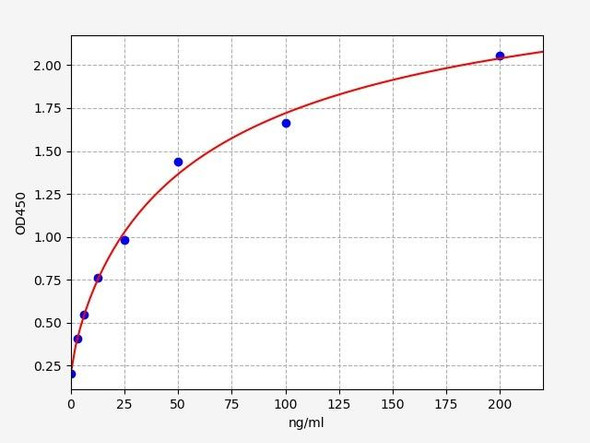Metabolism Antibodies 1
Anti-NPR1 Antibody (CAB10445)
- SKU:
- CAB10445
- Product Type:
- Antibody
- Reactivity:
- Human
- Reactivity:
- Mouse
- Reactivity:
- Rat
- Host Species:
- Rabbit
- Isotype:
- IgG
- Antibody Type:
- Polyclonal Antibody
- Research Area:
- Metabolism
Description
| Antibody Name: | Anti-NPR1 Antibody |
| Antibody SKU: | CAB10445 |
| Antibody Size: | 20uL, 50uL, 100uL |
| Application: | WB |
| Reactivity: | Human, Mouse, Rat |
| Host Species: | Rabbit |
| Immunogen: | Recombinant fusion protein containing a sequence corresponding to amino acids 260-470 of human NPR1 (NP_000897.3). |
| Application: | WB |
| Recommended Dilution: | WB 1:500 - 1:2000 |
| Reactivity: | Human, Mouse, Rat |
| Positive Samples: | 293T, HL-60, NCI-H460, HepG2, Mouse lung, Mouse liver, Rat brain |
| Immunogen: | Recombinant fusion protein containing a sequence corresponding to amino acids 260-470 of human NPR1 (NP_000897.3). |
| Purification Method: | Affinity purification |
| Storage Buffer: | Store at -20'C. Avoid freeze / thaw cycles. Buffer: PBS with 0.02% sodium azide, 50% glycerol, pH7.3. |
| Isotype: | IgG |
| Sequence: | EAGL CGED YVFF HLDI FGQS LQGG QGPA PRRP WERG DGQD VSAR QAFQ AAKI ITYK DPDN PEYL EFLK QLKH LAYE QFNF TMED GLVN TIPA SFHD GLLL YIQA VTET LAHG GTVT DGEN ITQR MWNR SFQG VTGY LKID SSGD RETD FSLW DMDP ENGA FRVV LNYN GTSQ ELVA VSGR KLNW PLGY PPPD IPKC GFDN EDPA CNQD HLS |
| Gene ID: | 4881 |
| Uniprot: | P16066 |
| Cellular Location: | Membrane, Single-pass type I membrane protein |
| Calculated MW: | 118kDa |
| Observed MW: | 160kDa |
| Synonyms: | NPR1, ANPRA, ANPa, GUC2A, GUCY2A, NPRA |
| Background: |
| UniProt Protein Function: | ANPA: natriuretic peptide receptor A, which mediates natriuretic, diuretic, and vasorelaxing actions of the natriuretic peptides. Contains five functional domains: an extracellular ligand-binding domain, a single membrane-spanning region, and intracellularly a protein kinase homology domain, a helical hinge region involved in oligomerization, and a carboxyl-terminal guanylyl cyclase catalytic domain. Belongs to the adenylyl cyclase class-4/guanylyl cyclase family. Has guanylate cyclase activity on binding of ANF. Hypertensive SHR Rat has polymorphism at the locus. Human non-coding polymorphisms can alter expression up to two-fold, and have been associated with hypertension. A coding SNP is associated with hypertension and myocardial infarction. |
| UniProt Protein Details: | Protein type:Guanylyl cyclase; Protein kinase, RGC; Lyase; Protein kinase, dual-specificity (receptor); Nucleotide Metabolism - purine; Kinase, protein; EC 4.6.1.2; Receptor, misc.; Membrane protein, integral; RGC group; RGC family Chromosomal Location of Human Ortholog: 1q21-q22 Cellular Component: guanylate cyclase complex, soluble; integral to plasma membrane; plasma membrane; receptor complex Molecular Function:adenylate cyclase activity; ATP binding; GTP binding; guanylate cyclase activity; hormone binding; natriuretic peptide receptor activity; peptide hormone binding; peptide receptor activity, G-protein coupled; protein kinase activity; protein kinase binding Biological Process: body fluid secretion; cell surface receptor linked signal transduction; cGMP biosynthetic process; dopamine metabolic process; G-protein coupled receptor protein signaling pathway; negative regulation of angiogenesis; negative regulation of cell growth; negative regulation of smooth muscle cell proliferation; positive regulation of cGMP biosynthetic process; protein amino acid phosphorylation; receptor guanylyl cyclase signaling pathway; regulation of blood pressure; regulation of vascular permeability; regulation of vasodilation |
| NCBI Summary: | Guanylyl cyclases, catalyzing the production of cGMP from GTP, are classified as soluble and membrane forms (Garbers and Lowe, 1994 [PubMed 7982997]). The membrane guanylyl cyclases, often termed guanylyl cyclases A through F, form a family of cell-surface receptors with a similar topographic structure: an extracellular ligand-binding domain, a single membrane-spanning domain, and an intracellular region that contains a protein kinase-like domain and a cyclase catalytic domain. GC-A and GC-B function as receptors for natriuretic peptides; they are also referred to as atrial natriuretic peptide receptor A (NPR1) and type B (NPR2; MIM 108961). Also see NPR3 (MIM 108962), which encodes a protein with only the ligand-binding transmembrane and 37-amino acid cytoplasmic domains. NPR1 is a membrane-bound guanylate cyclase that serves as the receptor for both atrial and brain natriuretic peptides (ANP (MIM 108780) and BNP (MIM 600295), respectively).[supplied by OMIM, May 2009] |
| UniProt Code: | P16066 |
| NCBI GenInfo Identifier: | 113912 |
| NCBI Gene ID: | 4881 |
| NCBI Accession: | P16066.1 |
| UniProt Secondary Accession: | P16066,Q5SR08, Q6P4Q3, B0ZBF0, |
| UniProt Related Accession: | P16066 |
| Molecular Weight: | 118,919 Da |
| NCBI Full Name: | Atrial natriuretic peptide receptor 1 |
| NCBI Synonym Full Names: | natriuretic peptide receptor 1 |
| NCBI Official Symbol: | NPR1 |
| NCBI Official Synonym Symbols: | ANPa; NPRA; ANPRA; GUC2A; GUCY2A |
| NCBI Protein Information: | atrial natriuretic peptide receptor 1 |
| UniProt Protein Name: | Atrial natriuretic peptide receptor 1 |
| UniProt Synonym Protein Names: | Atrial natriuretic peptide receptor type A; ANP-A; ANPR-A; NPR-A; Guanylate cyclase A; GC-A |
| Protein Family: | Phosphoglucomutase |
| UniProt Gene Name: | NPR1 |
| UniProt Entry Name: | ANPRA_HUMAN |






